We find that the W/10DeltaT numbers are by far the most useful way to look at performance. If we put all these numbers together in tables then we have a sea of numbers and it’s hard to see exactly which radiators are good or bad even if we color code the results:
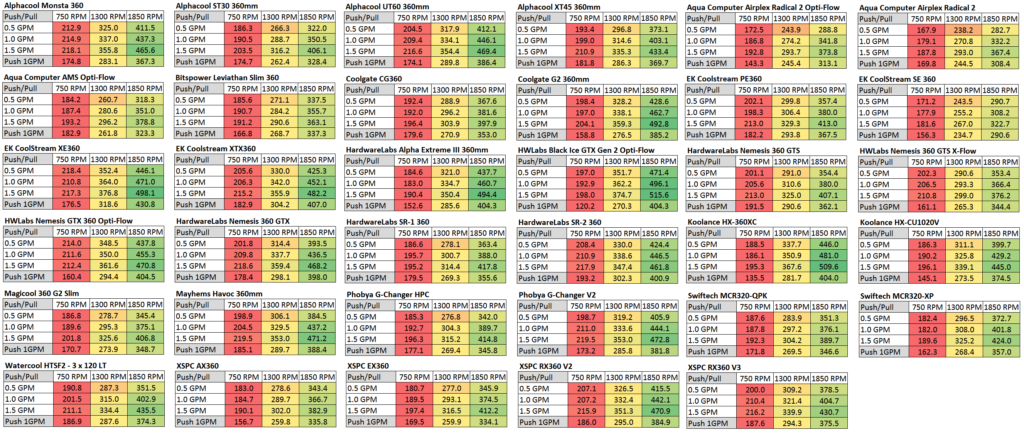
So let’s split up the test points and compare each in turn starting with the push only data at 750RPM.
Performance with GT AP15 Fans in Push at 750 rpm Comparison:
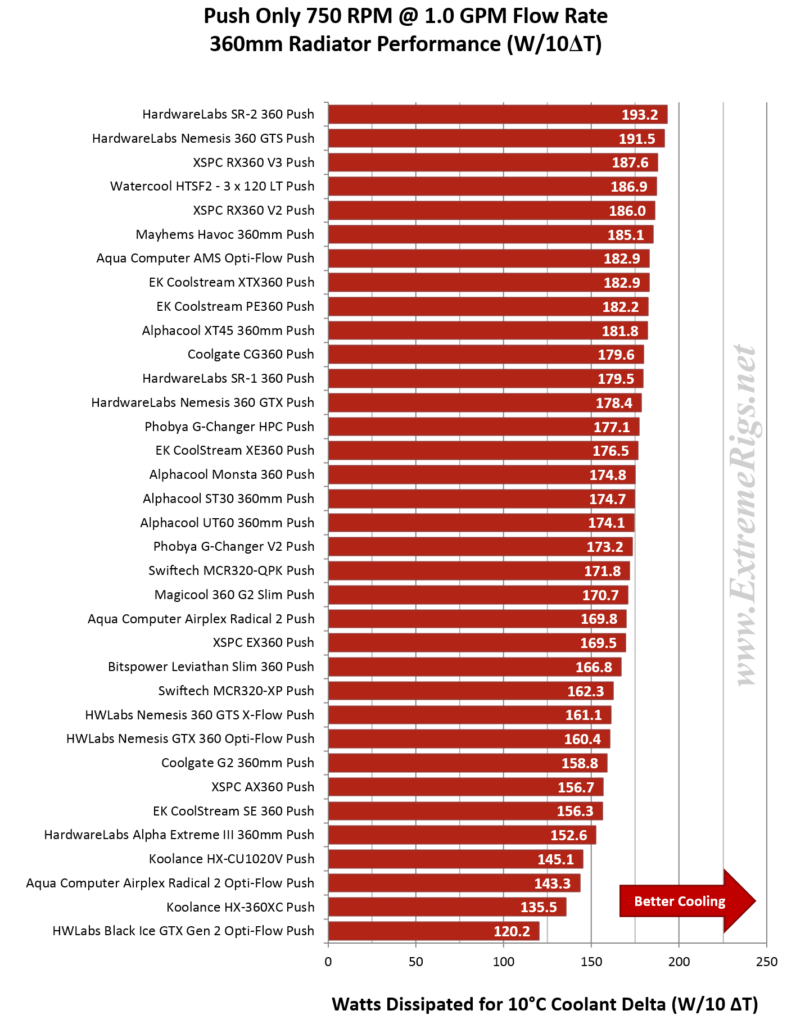
First off let’s note just how low these power dissipation numbers are. A single 360 radiator at 750RPM is going to struggle to cool a fully loaded overclocked hex core cpu or GPU. At 750RPM we can also see that in the middle of the pack that 22 radiators have only a small difference between them – approximately 20W or 10% is the total spread of those 22. The lowest two performers are radiators with very dense fins (high fpi) that are geared towards much higher air pressures/flows. At this low RPM the fans can not push much air through the dense fin structure. While the SR-2 leads this plot the real surprise is just how well the slim HWLabs Nemesis GTS radiator does. Usually a slim radiator is a performance compromise, but here we are not seeing any compromise.
As this is our first real comparison plot it’s worth again reiterating our measurement error. Despite our best efforts to measure everything far more accurately than any other test has been done we still end up with at best a +/- 1% error. With 22 radiators taking up the same 10% then clearly there is a lot of performance overlap.
Let’s now focus on only the slim radiators – these are radiators that are below 35mm in width:
While the Nemesis GTS didn’t stand out before when comparing all radiators, once the other slim radiators are isolated it’s much more obvious just how much of a dominating result it is.
Performance with GT AP15 Fans in Push at 1300 rpm Comparison:
At 1300 RPM fan noise levels are still very quiet but we see a meaningful increase in amount of power that can be dissipated. We also start seeing the group spread apart a bit. The XE takes a clear lead of ~5% over the next radiator which is far beyond our measurement error. While the main pack has spread out a small amount the most noticeable thing is that the super dense radiators that really struggled at 750RPM have now accelerated up the charts.
If we focus on the slim radiators only we see that the Nemesis GTS is still in the lead by a good chunk:
While EK’s SE trails at the bottom of the pack it should be remembered that the SE is not only the slimmest radiator at 27mm but it’s also narrow. This means that it has the smallest volume “core” of any radiator in the test.
Performance with GT AP15 Fans in Push at 1850 rpm Comparison:
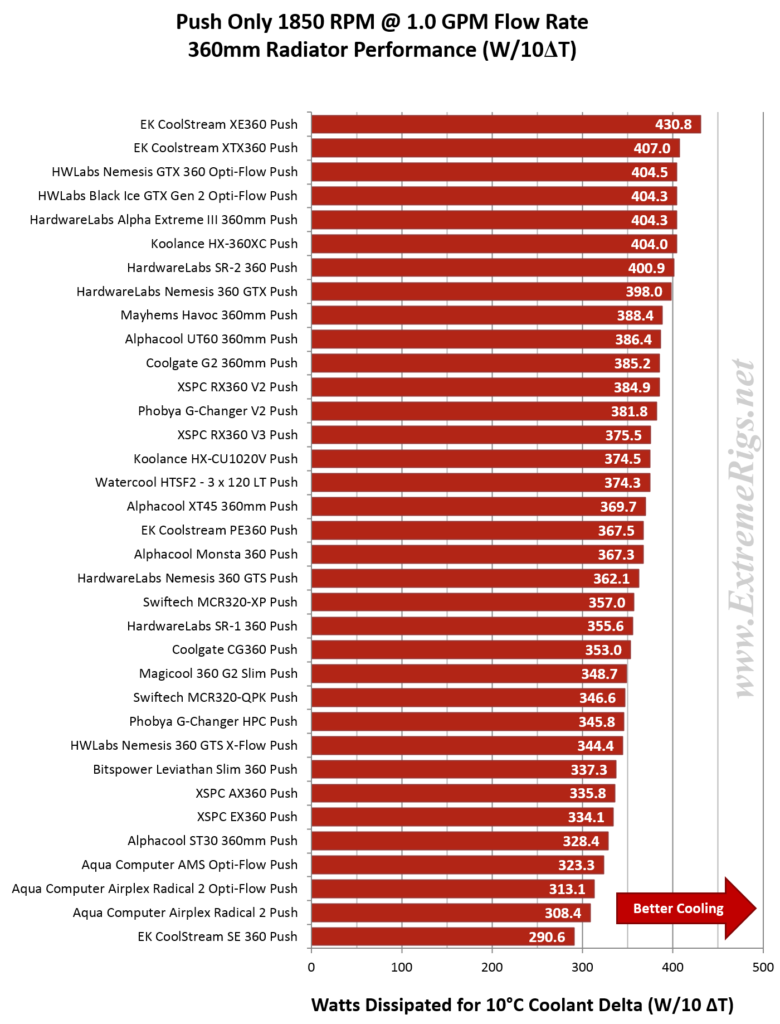 At 1850RPM fans become noisy enough to annoy those with sensitive ears. However the performance jump here is significant. The XE is extending it’s lead to 6% over the next nearest radiator. This is a huge surprise that given all the radiator improvements we’ve seen over the years that one radiator could dominate this test point so much. At this air speed we really start to see the thinner radiators starting to fall behind. In particular the slimmest design, EK’s SE, is now 33% behind it’s thicker brother (XE).
At 1850RPM fans become noisy enough to annoy those with sensitive ears. However the performance jump here is significant. The XE is extending it’s lead to 6% over the next nearest radiator. This is a huge surprise that given all the radiator improvements we’ve seen over the years that one radiator could dominate this test point so much. At this air speed we really start to see the thinner radiators starting to fall behind. In particular the slimmest design, EK’s SE, is now 33% behind it’s thicker brother (XE).
Unlike the EK’s XE, the Nemesis GTS does get overtaken at this higher speed. Koolance’s radiator is designed for higher airflow as it has a much more dense array of fins. Therefore this is not unsurprising.
Push/Pull
For Push/Pull data we measured 3 flow rates. Most radiators showed little variation with flow. Therefore in order to keep our extensive array of plots down we’ve chosen to just show the average of all three flow rates by default. If you’re a numbers junky we have presented all the flow rate data behind a spoiler at the bottom of this section.
Performance with GT AP15 Fans in Push/Pull at 750 rpm Comparison:
At 750RPM in Push/Pull the numbers are even closer than in push as the high FPI radiators do not suffer as the dual action really helps to get air through the radiator even at these low speeds. The SR2 is no longer top dog, though it’s still near the top. All the competitors are quite tightly grouped with no visible splits between the groups. Let’s also separate out the slim radiators by themselves:
Slim radiators aren’t typically used in push/pull, but the data is interesting nonetheless. As with the push case the Nemesis GTS in both variations is dominating with a good 6% over it’s nearest rival. EK’s super tiny SE radiator is of course at the bottom.
Performance with GT AP15 Fans in Push/Pull at 1300 rpm Comparison:
At 1300 RPM the radiators start diverging, with some radiators failing to scale to higher air pressures/flows, while those that do are starting to take off.
Let’s single out those slim radiators:
At 1300RPM the higher FPI radiators are starting to take over from the GTS. At 1850RPM this will no doubt continue.
Performance with GT AP15 Fans in Push/Pull at 1850 rpm Comparison:
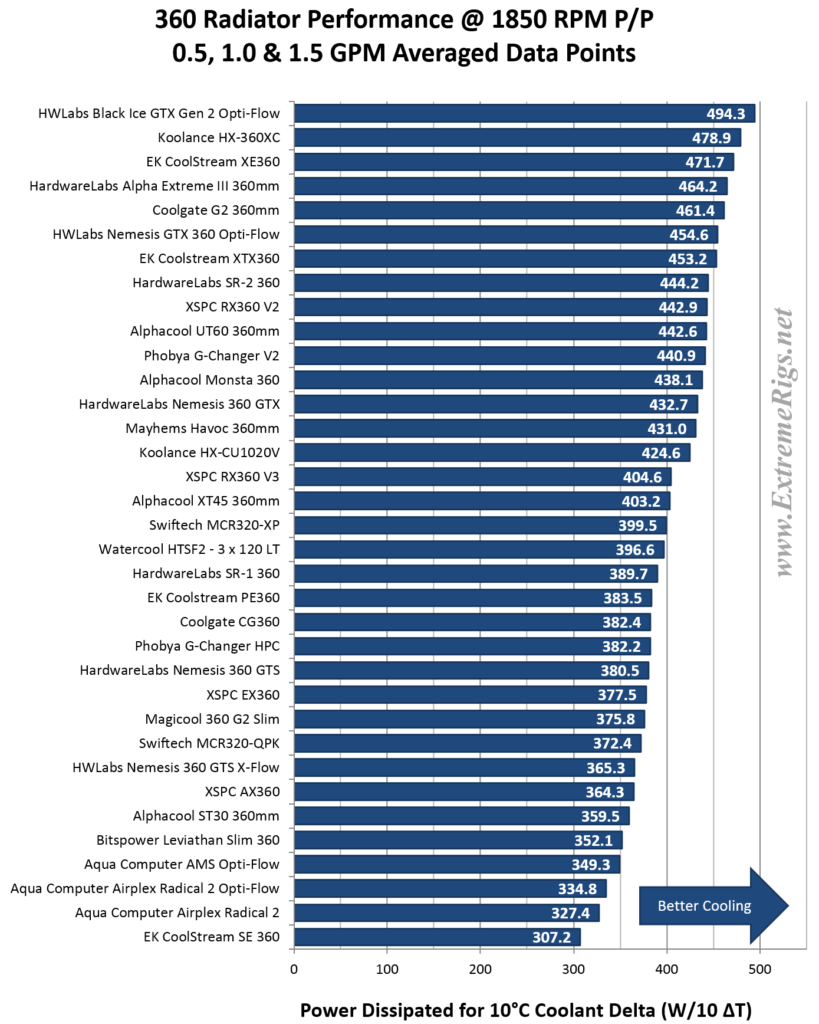
At 1850RPM the radiator that was the worst at 750RPM in push is now leading the pack. At 494W dissipation that is over 4 times what the same radiator acheived at 750RPM in push. Choosing the right radiator for your setup then is critical to maximizing performance. The performance spread now is quite large too, with the slimmest lowest performer lagging 38% behind the leading performer.
Koolance’s high FPI radiator pulls ahead further here, leaving the more balanced Swiftech XP behind. The GTS still takes third though which is very respectable given it’s performance across the entire range. The two narrow radiators take the two bottom spots, sorted by thickness.
Hidden Data vs Flow Rate:
Merged Data
Now to make all this *even* more confusing we can combine push and push/pull data at 1GPM into individual plots. However they get very busy and might be best viewed in a separate window zoomed in. Again let’s start with 750RPM.
Merged Push/Pull and Push Data at 750 RPM & 1GPM:
At 750RPM we can see that there is overlap between push and push/pull setups. Our original belief that push/pull was universally better in performance than push is not proven out by the real data. However there is still a significant boost to be had by choosing push/pull across the board for any radiator. Hardware Labs radiators here really stand out from the pack in a push setup with the SR2 and GTS quite far up the rankings in comparison to the next best from XSPC. Alphacool’s Monsta turns in it’s relatively best performance here too. Push/Pull helps to make use of it’s thickness while the low FPI suits the lower RPM fans.
Merged Push/Pull and Push Data at 1300 RPM & 1GPM:
At 1300RPM the overlap between push and push/pull increases even though the top performing push/pull radiators now start pulling away from the middle of the pack. Here again it’s clear to see that EK’s XE radiator is significantly far ahead in a push setup beating out quite a few push/pull setups. It also manages to top the push/pull charts by a narrower margin.
Merged Push/Pull and Push Data at 1850 RPM & 1GPM:
At 1850RPM the top two push/pull radiators are accelerating away as they grow into their element. The XE is turning in an amazing performance. With a radiator like the XE you really are not giving up much performance when using only push, and if you choose to run push/pull it’s still packing top notch performance.
Relative Scores
Having separated the results out like this though helps to pick winners of individual categories but it’s still not obvious how each radiators is tuned – i.e. whether they are all-rounders or more specifically focused for higher or lower speeds. To do this we assign 100 to the highest performer at each setting that we test. Then every radiator gets a score as a percentage of this:
While this is useful for looking at a specific radiator, it’s really hard to take all this in and remember how each radiator did. There are a few standouts though that show a lot of green – the XE 360 and the Hardware Labs Black Ice GTX. The former excels across the board, while the GTX excels at push/pull.
It also lets us see which radiators just don’t perform well at all like the EK SE 360. However we have to also bear in mind that some of these radiators are targeted at different markets. Some are slim radiators for smaller cases. Some like the SR-1 are designed for optimized air flow, while others bring more features to the table.
Now that we’ve looked at specific cases – let’s make some simpler more general performance metrics:








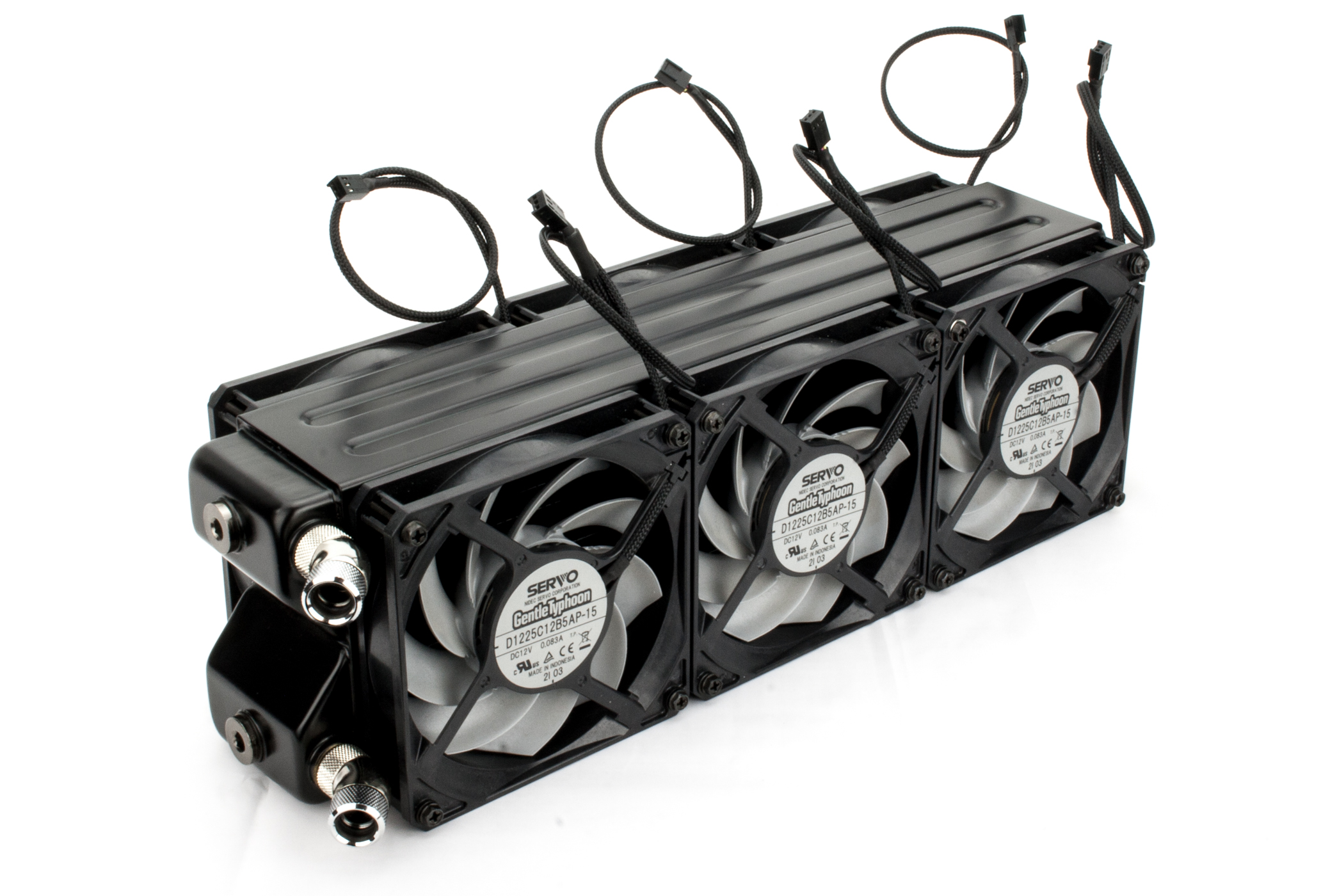
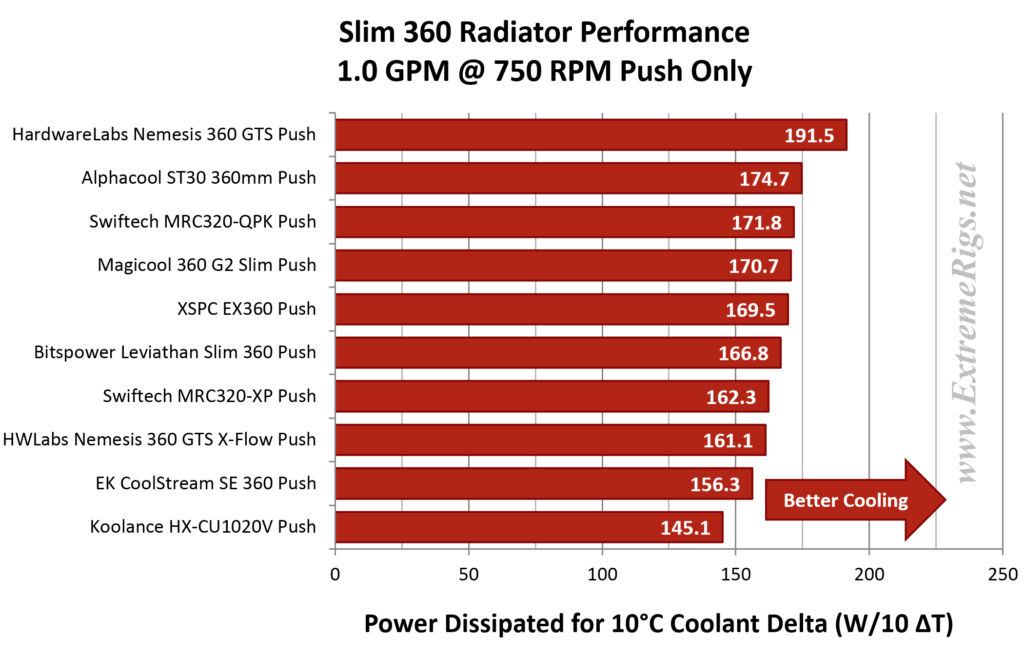
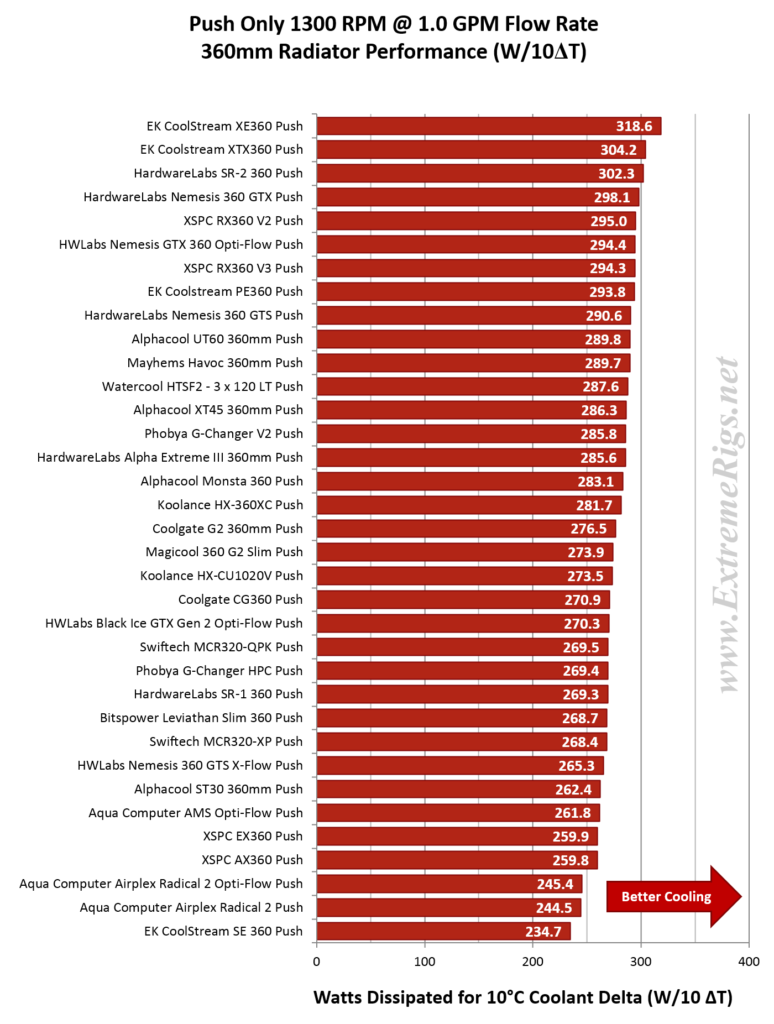
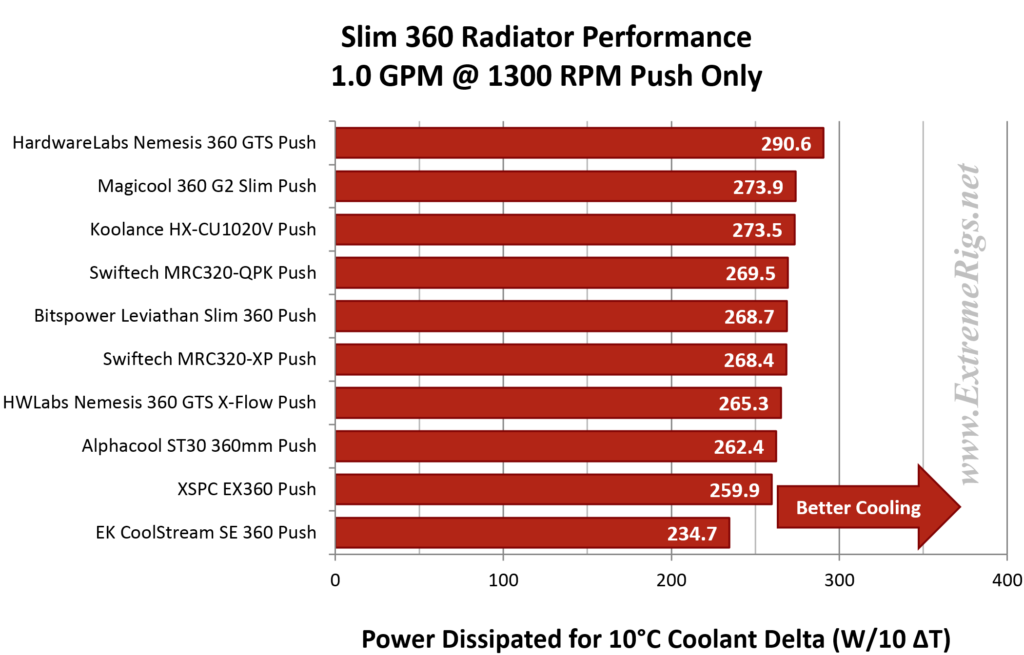
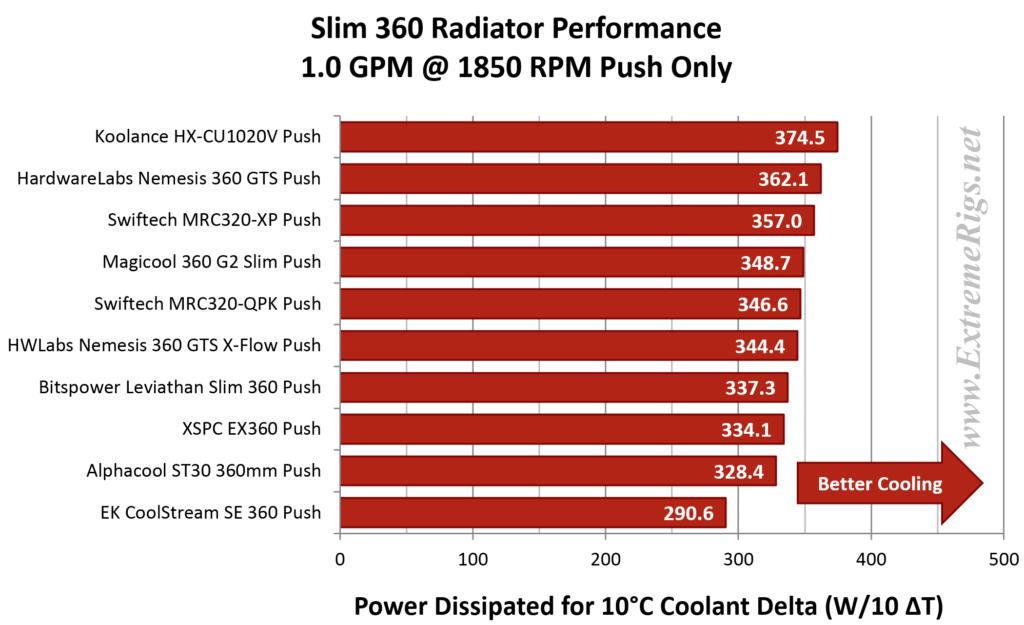
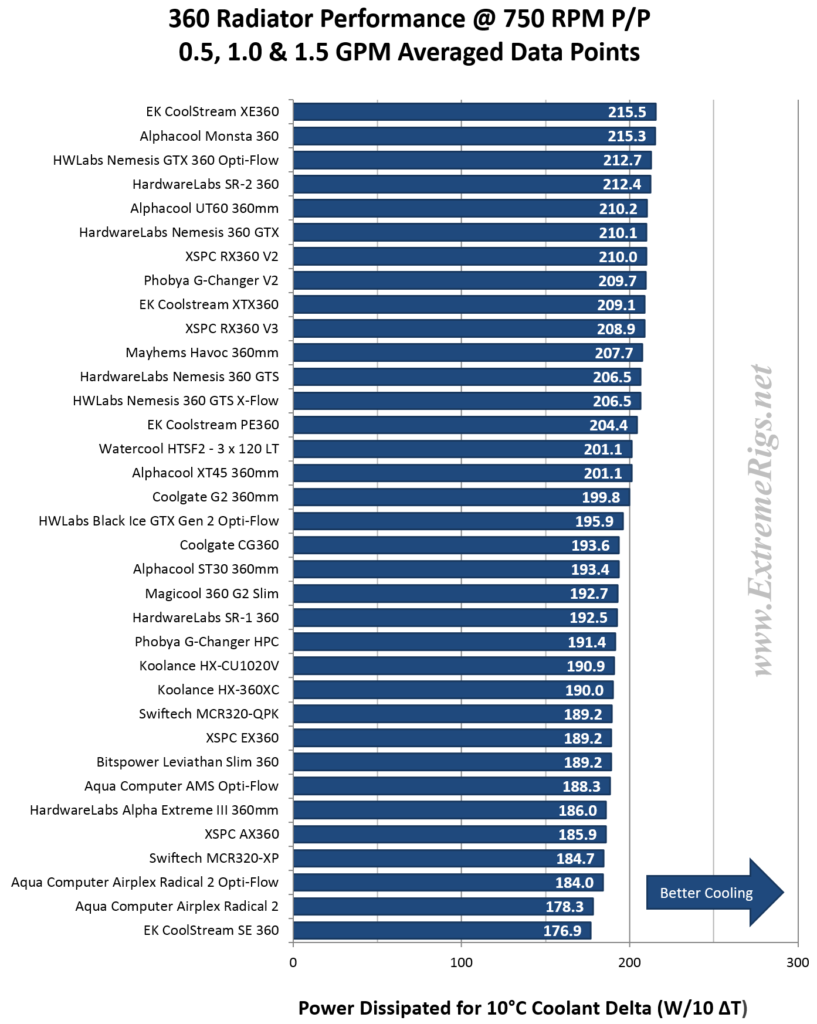
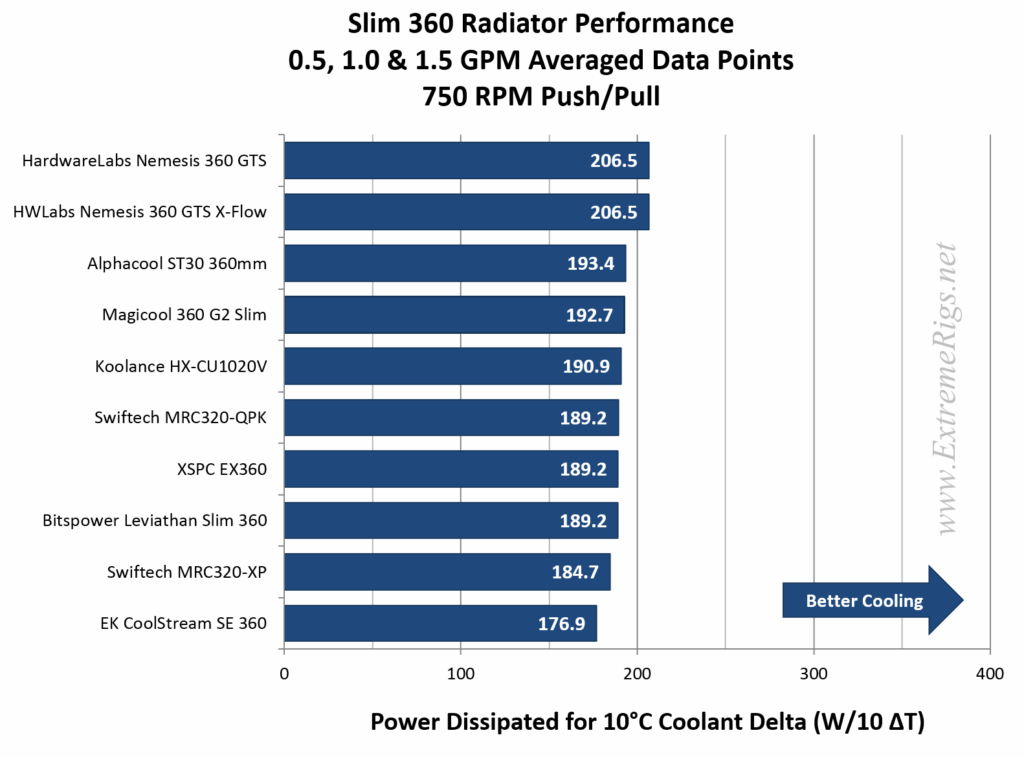
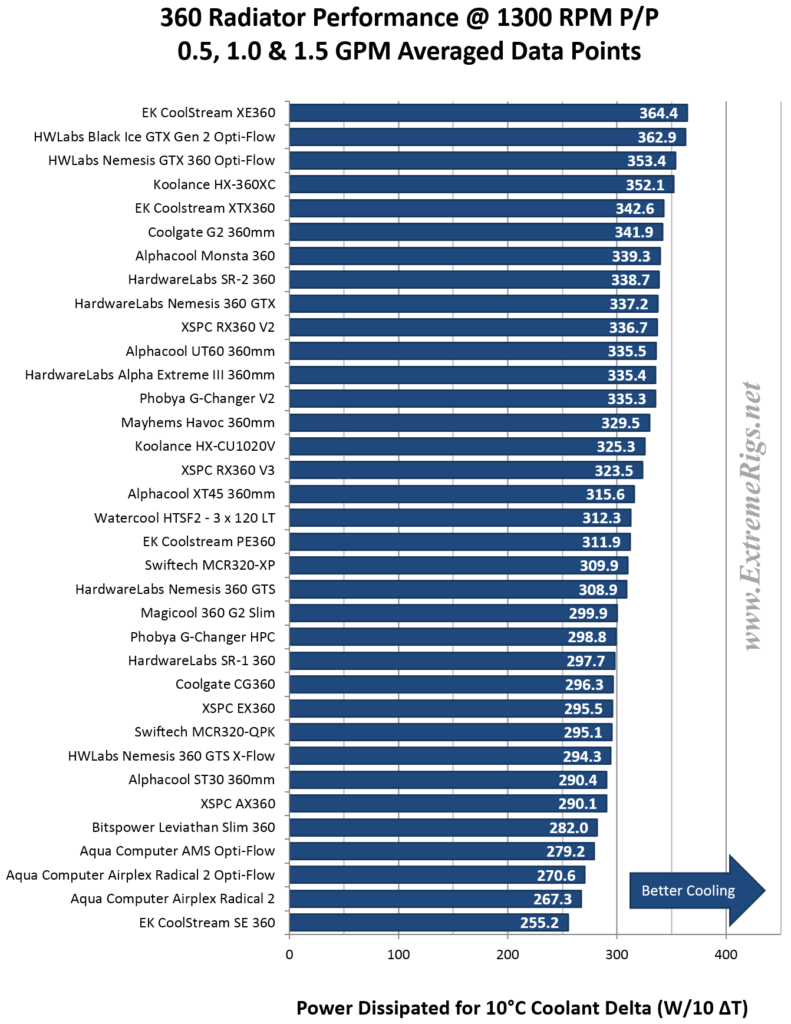
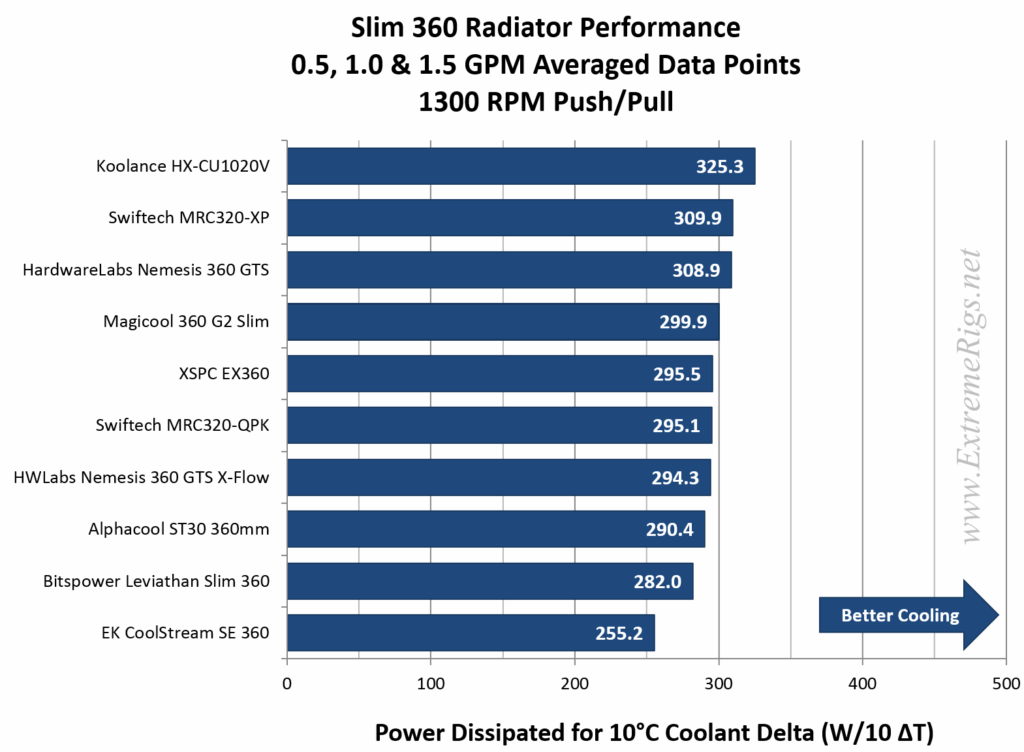
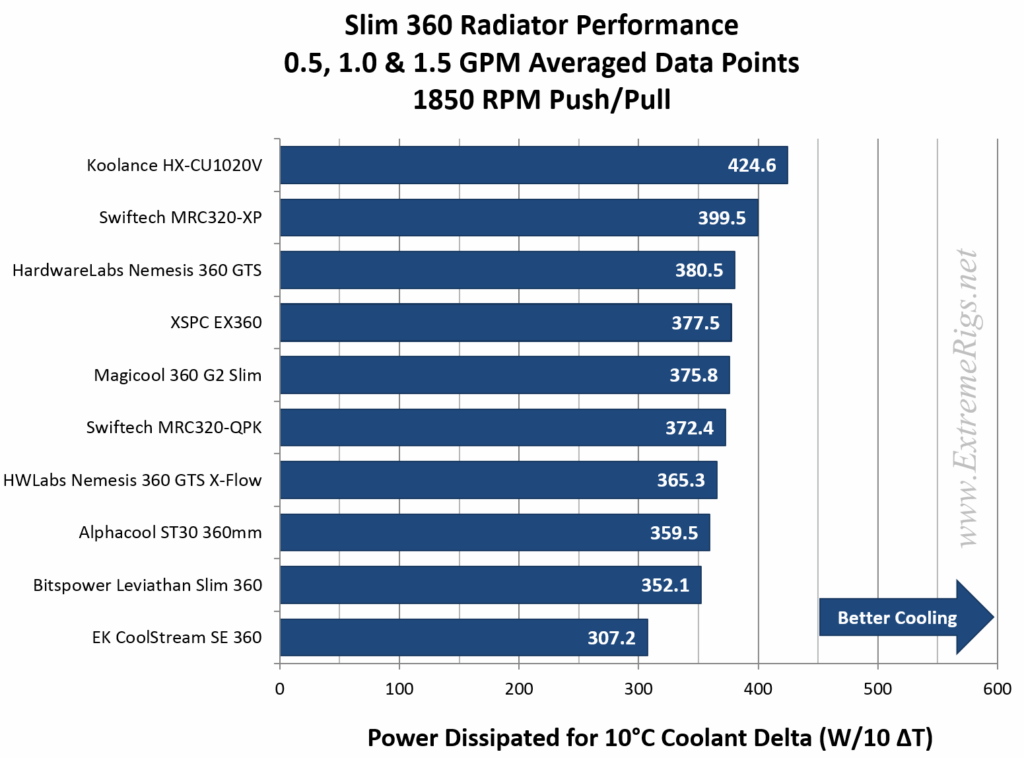
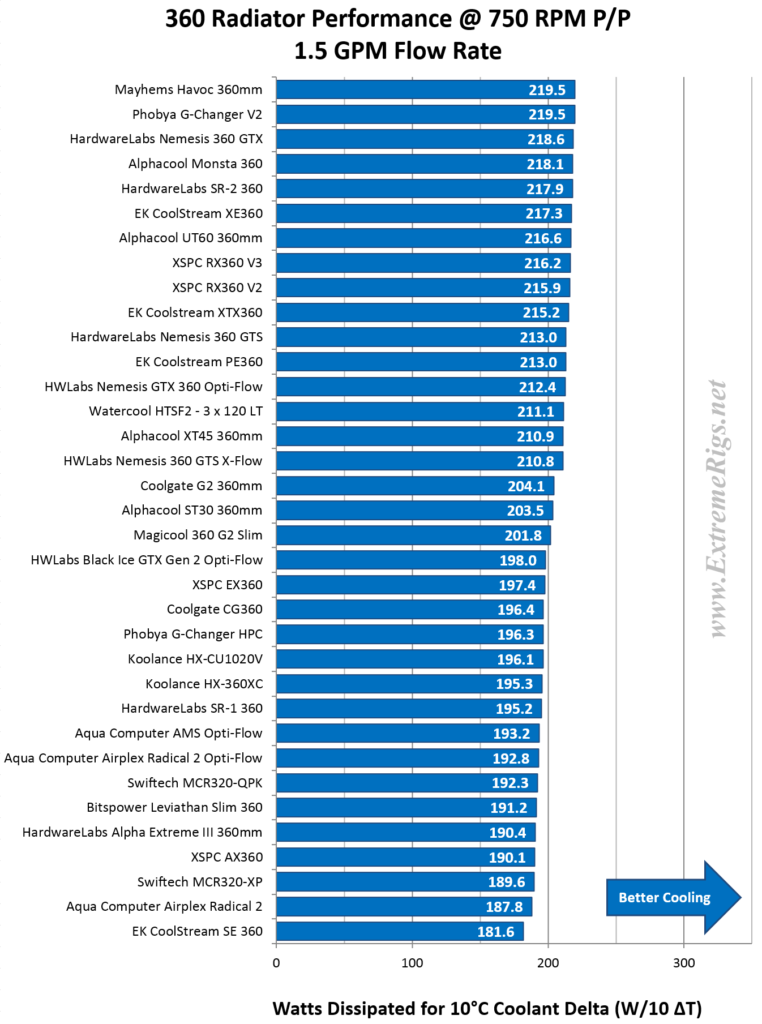
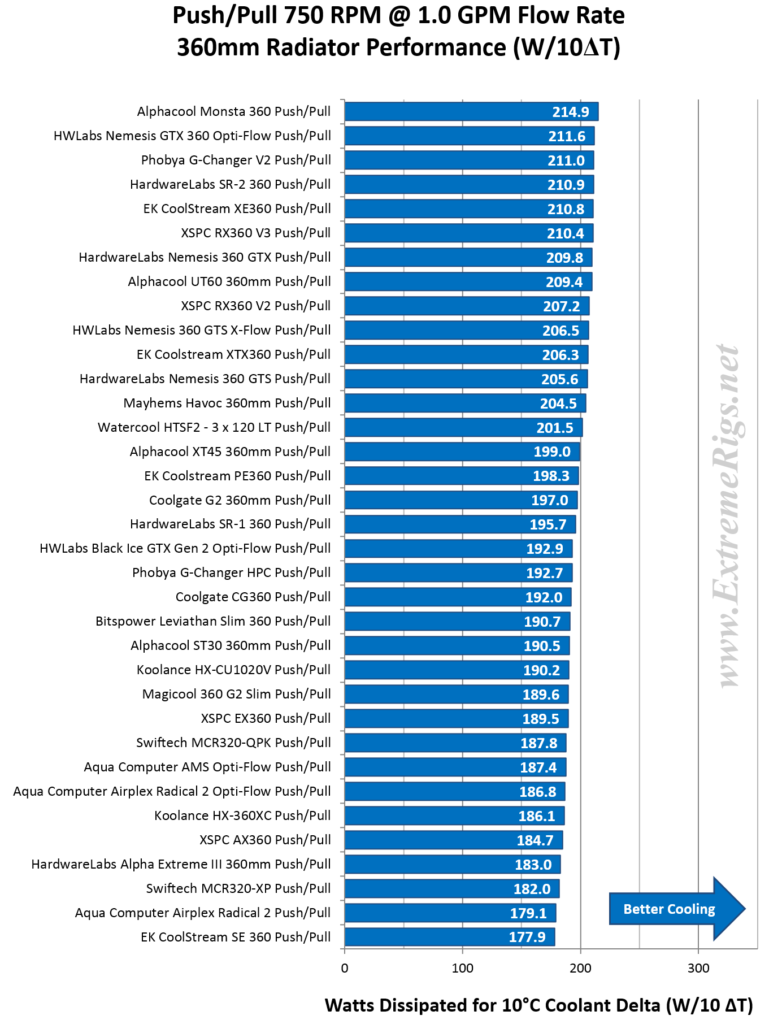
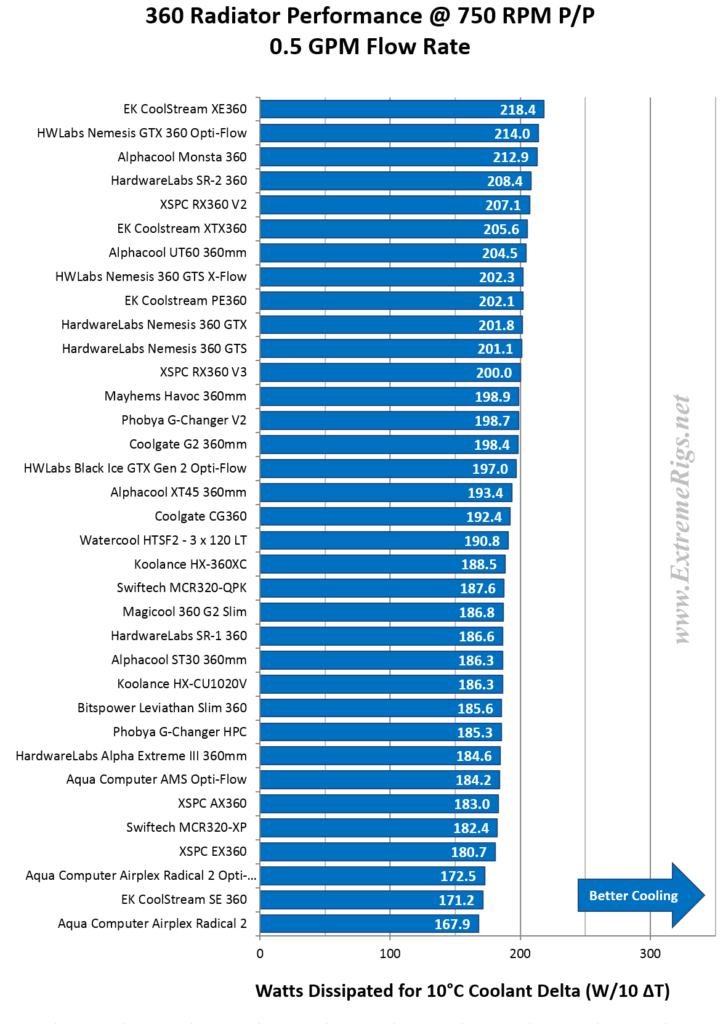
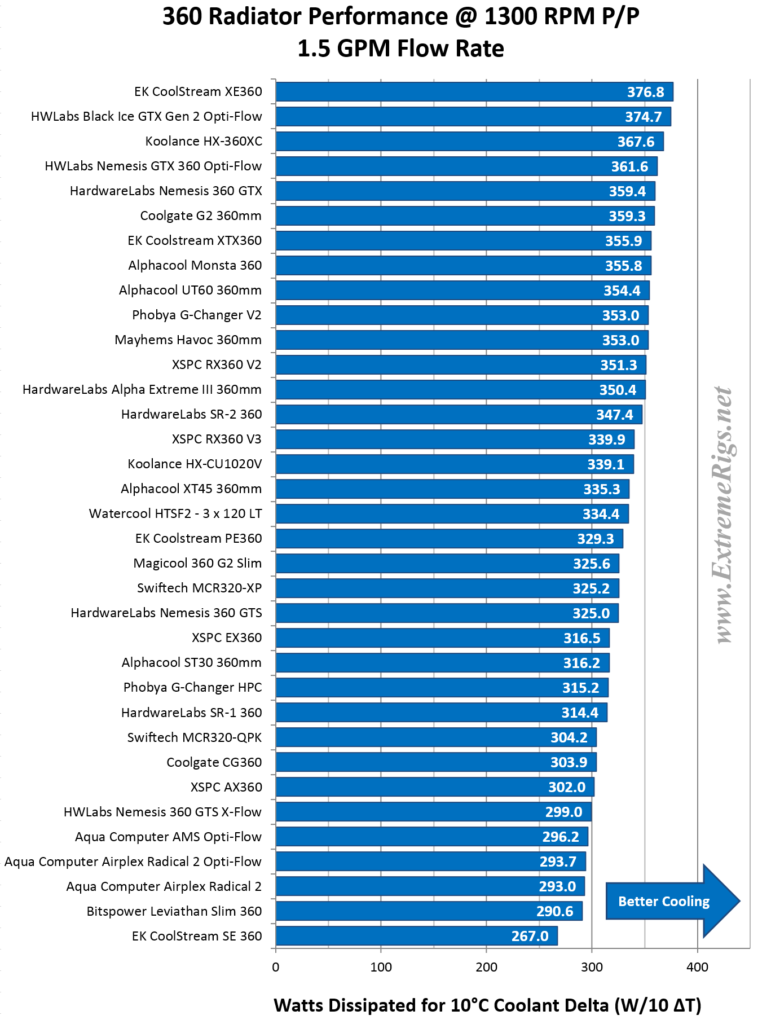
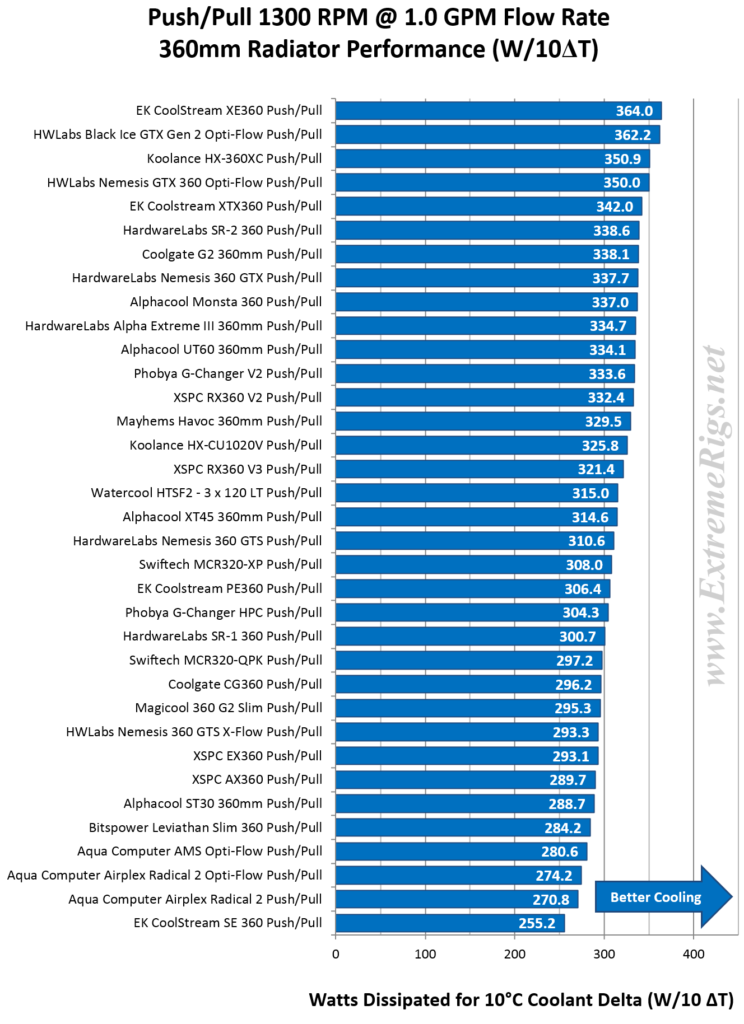
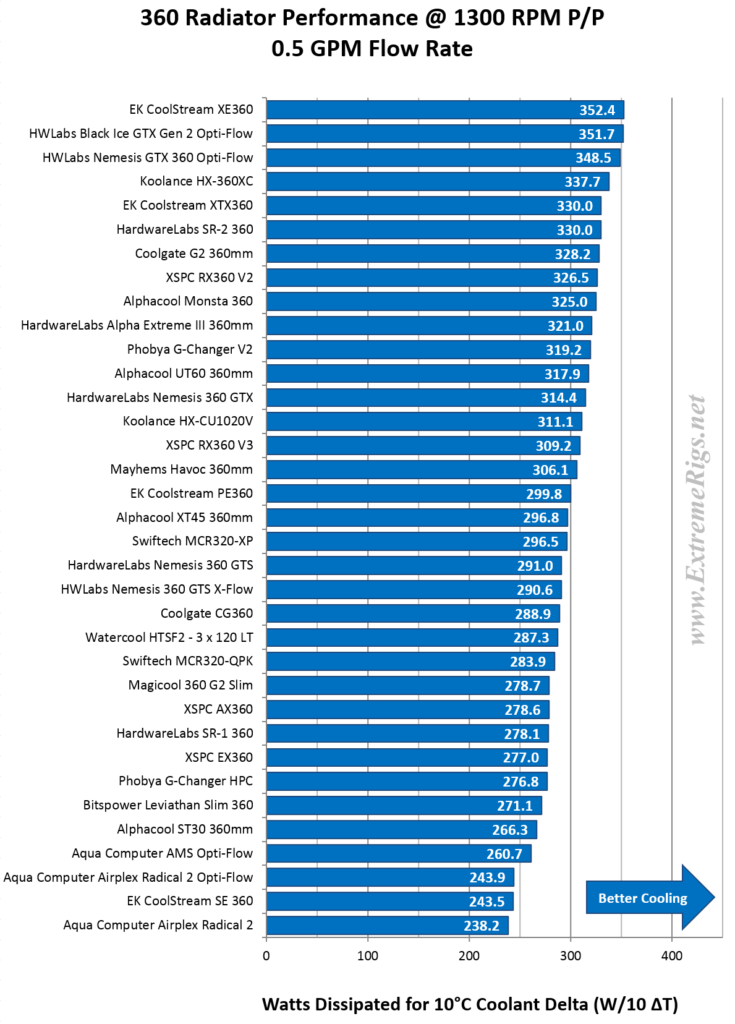
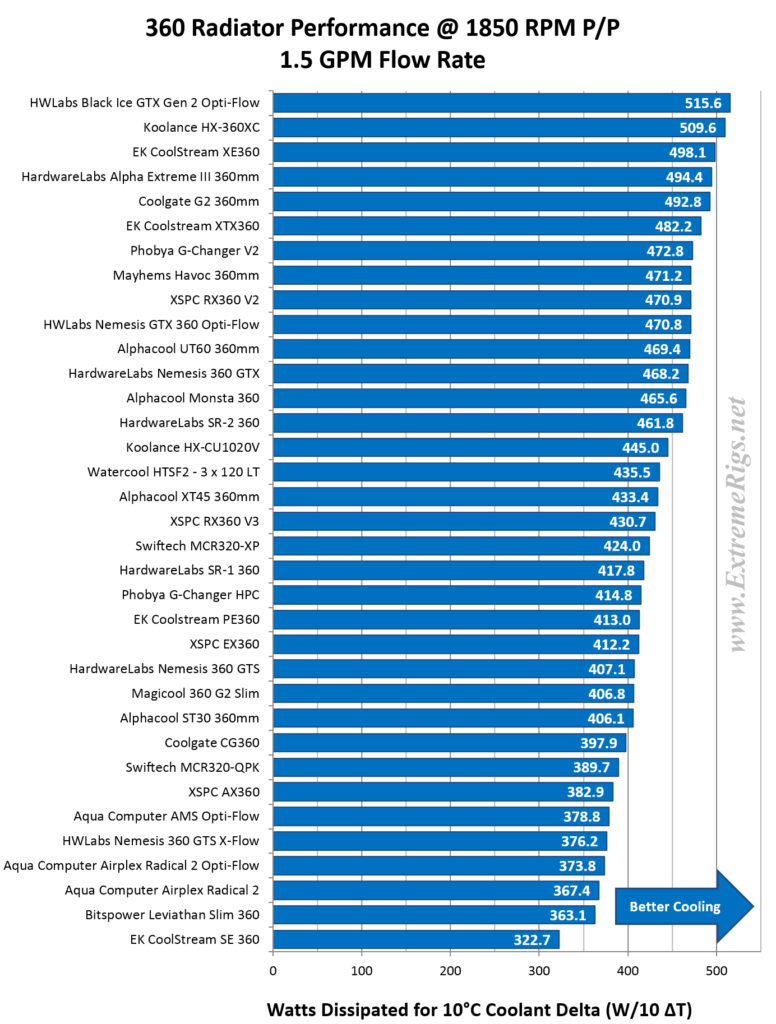
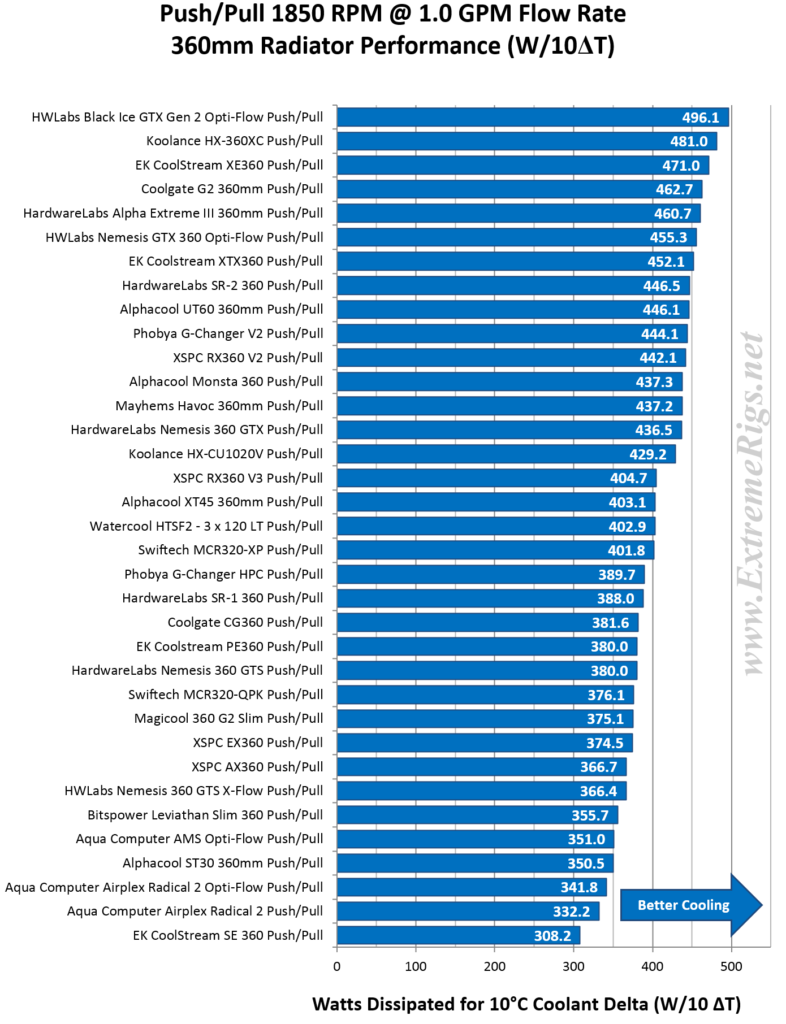
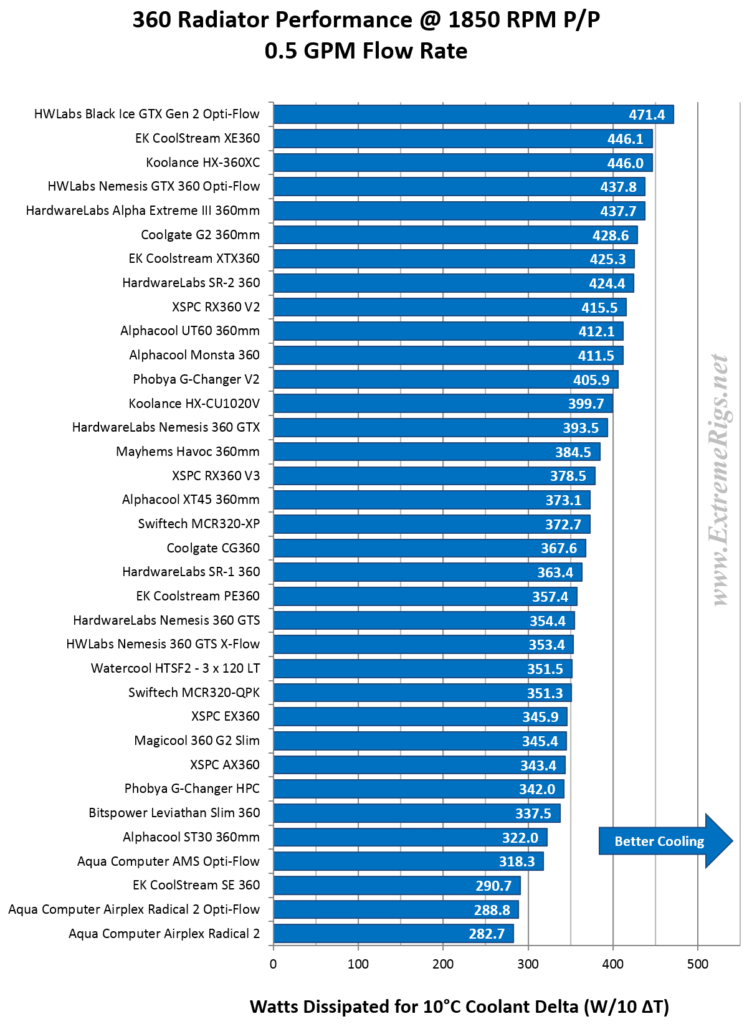
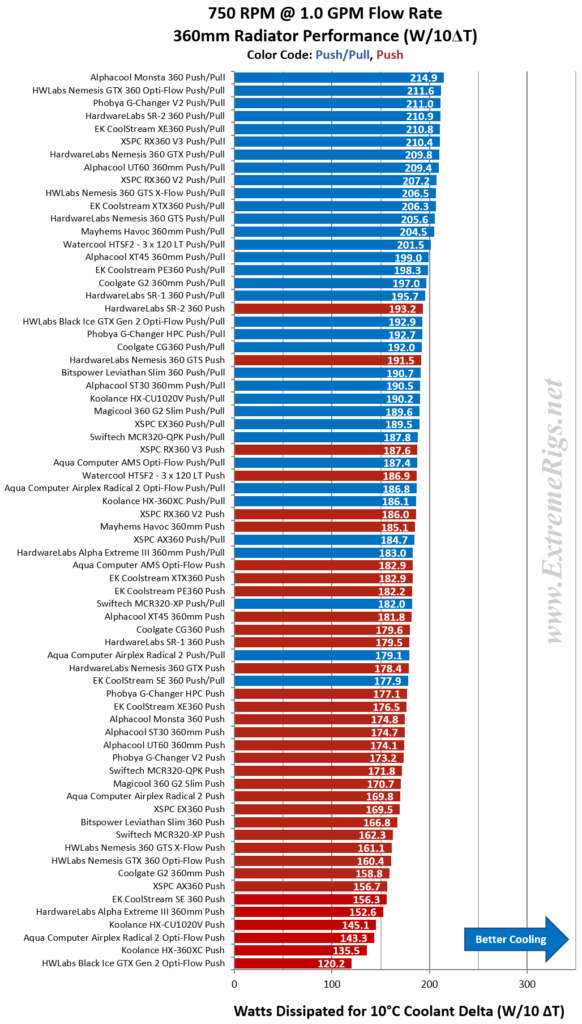
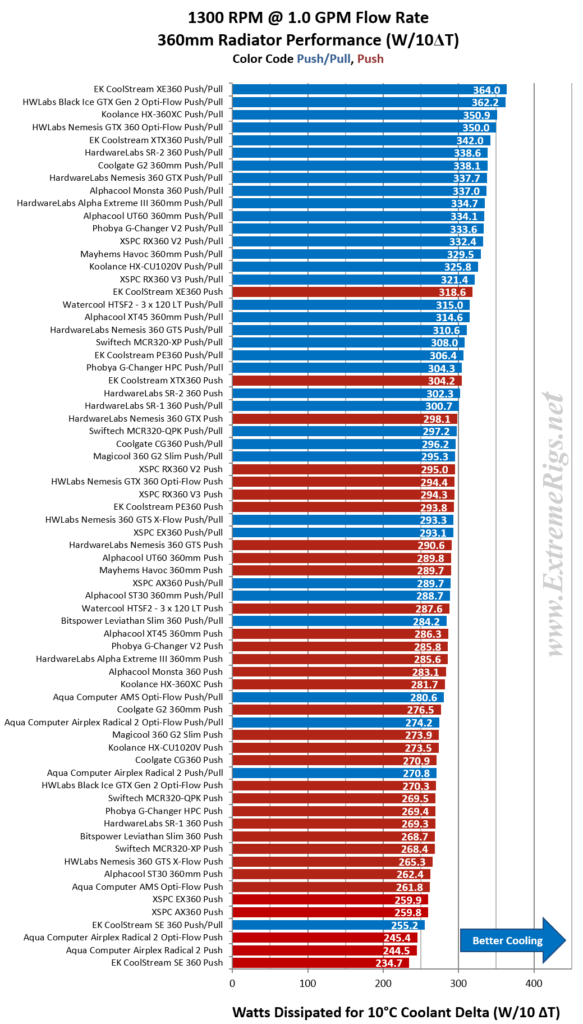
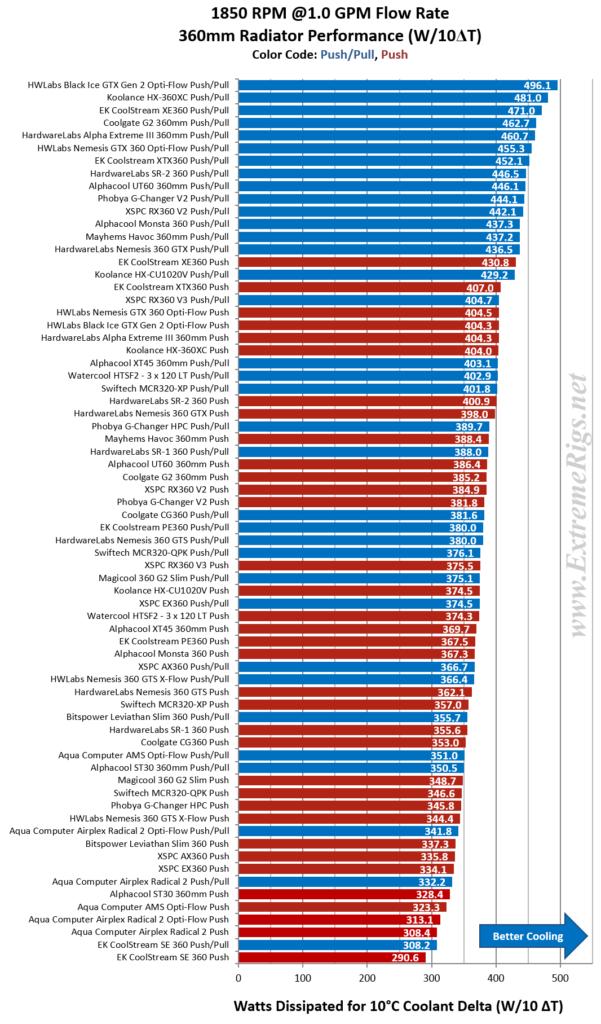




Great Work … a new standard for radiator testing.
The Koolance was a surprisingly good result. Push pull makes a bigger difference than many think.
I’m happy my EK PE rads did OK, mostly keeping up with the XT45 rads they replaced.
The extra 5mm the PE rads allowed made the difference between push only and push pull for an overall better result
Yeah the huge shrouds on the PE mean that it’s really a slim radiator core tucked into the body of a medium radiator wrapper. I do wonder if reducing the shrouds would have made no real change in performance but would have meant it could have won a slim award!
Also not sure what you mean about push only – we haven’t tested one set of fans yet
I meant in my system
This is the best radiator test review I´ve ever seen, great job, guys!
[…] we published the 2015 Radiator Round Up data, there was some pushback from quite a few different manufacturers claiming our use of […]
[…] information and performance data about the Mayhems Havoc 360mm Radiator for inclusion in the Extreme Rigs Rad Round Up 2015. I’ll be keeping the review section short and factual, focusing on presenting the performance […]
[…] […]
Weighing in a bit late, but I just found this article (and the site). This was a great read! Thank you for doing this type of thing. There are many of us out there who want to upgrade, add to, or change our rigs completely. In depth articles like this are the life-bread for us regular folk to gather REAL information.
I do have a question and of course am hoping you find this comment: How about testing the XSPC AX series radiators? I don’t know how you get your samples, but it would be interesting to see how they perform against the rads in this test.
More fan tests would be a wonderful thing as well. Enermax has had the UCTP12P High Static Pressure PWM 120mm Fan out for some time with no virtually no information anywhere as to their validity for use a radiator fan. I noticed you folks have a pre-production sample Vardar from EK. I look forward to seeing how that plays out in production.
Yes we wanted to test the AX series too! We are planning to do more fan tests also
[…] and performance data about the HardwareLabs Nemesis 360 GTS Radiator for inclusion in the Extreme Rigs Rad Round Up 2015. I’ll be keeping the review section short and factual, focusing on presenting the performance […]
[…] is to provide information and performance data about the EK XTX 360mm Radiator for inclusion in the Extreme Rigs Rad Round Up 2015. I’ll be keeping the review section short and factual, focusing on presenting the performance […]
[…] a lot on radiator that which i should get for… i found a great… probably best… article at Radiator Review Round Up 2015 – ExtremeRigs.net you can notice that coolgate g2 radiator is really great radiator for both performance and […]
[…] information and performance data about the XSPC EX360 v2 360mm Radiator for inclusion in the Extreme Rigs Rad Round Up 2015. I’ll be keeping the review section short and factual, focusing on presenting the performance […]
[…] information and performance data about the Alphacool UT60 360mm Radiator for inclusion in the Extreme Rigs Rad Round Up 2015. I’ll be keeping the review section short and factual, focusing on presenting the performance […]
[…] information and performance data about the Alphacool Monsta 360mm Radiator for inclusion in the Extreme Rigs Radiator Round Up 2015. I’ll be keeping the review section short and factual, focusing on presenting the performance […]
Hey fast nate
i was wondering how close you are to finishing the radiator roundup with just the push fan setup? thanks man
Hey Mike – Stren here, fast_fate is working hard but there’s probably still a few more weeks to go. For the most recent push data take a look at the Monsta review which has the “so far” data:
https://www.xtremerigs.net/2015/03/25/alphacool-nexxxos-monsta-360-radiator-review/6/
[…] We expect the performance to be identical to the current version as only the port options appear to be different. We’ll be getting this one into the thermal test chamber for some performance scrutiny very soon so look forward to a full review soon and inclusion into the Rad Review Round Up 2015. […]
[…] […]
Well, I think that the reviewers always get a mint rad. I already had to send back a Phobya G-ghanger 360 V2, a Phobya G-canger 420 V2, a Alphacool UT 60 420 , a Coolgate CG360CG2 and a Coolgate CG480CG2 , this because of heavy paint faults, scuff marks on the side panels , matt grey spots where paint is of, and the phobya 420 had a piece loose inside the rad. Al bad rads and these al got delivered and send back the last 2 months. The brands are asking good money, but deliver bad quality.
[…] about the Aqua Computer AMS (Airplex Modularity System) Copper 360mm Radiator for inclusion in the Extreme Rigs Rad Round Up 2015. I’ll be attempting to keeping the review section short and factual, focusing on presenting the […]
[…] provide information and performance data about the HWLabs SR2 360mm Radiator for inclusion in the Extreme Rigs Rad Round Up 2015. I’ll be keeping the review section short and factual, focusing on presenting the performance […]
[…] information and performance data about the Phobya G-Changer HPC 360mm Radiator for inclusion in the Extreme Rigs Rad Round Up 2015. I’ll be keeping the review section short and factual, focusing on presenting the performance […]
[…] is to provide information and performance data about the EK XE 360mm Radiator for inclusion in the Extreme Rigs Rad Round Up 2015. I’ll be keeping the review section short and factual, focusing on presenting the performance […]
I just posted this same comment on the other review for the Coolgate CG-360G2. I want to thank you for this extensive and extremely detailed review; an updated version to SkinneeLabs.com’s review and Martinliquidlab’s review on radiators (found here: https://martinsliquidlab.wordpress.com/category/radiators/). I was debating (as I’m a reseller for Koolance), weather or not to purchase the Koolance HX-360XC product or the Coolgate CG-360G2. As a result of your thorough testing I’m going to go with the Coolgate CG-360G2. I know you mentioned that it’s hard enough to put just one of these bad boys in your CaseLabs PC Case, but I’m going to put TWO of them in. My config will be set up like this:
25mm Fan/65mm Rad/25mm Fan/65mm Rad/25mm Fan = 205 (sandwiched together side by side)
Which will just cover the bottom of the width of my Origin Genesis PC Case. I’ll post the results later in a couple of months once I’m finished with my (hopeful) new Hackintosh build. We’ll see what happens. Again, thank you for your help. Greatly appreciated !!!
[…] is to provide information and performance data about the EK PE 360mm Radiator for inclusion in the Extreme Rigs Rad Round Up 2015. I’ll be keeping the review section short and factual, focusing on presenting the performance […]
[…] information and performance data about the Koolance HX-360XC 360mm Radiator for inclusion in the Extreme Rigs Rad Round Up 2015. I’ll be keeping the review section short and factual, focusing on presenting the performance […]
[…] information and performance data about the Watercool HTSF2 3 x 120 LT radiator for inclusion in the Extreme Rigs Rad Round Up 2015. I’ll be keeping the review section short and factual, focusing on presenting the performance […]
[…] is to provide information and performance data about the XSPC EX360 Radiator for inclusion in the Extreme Rigs Rad Round Up 2015. I’ll be keeping the review section short and factual, focusing on presenting the performance […]
[…] to provide information and performance data about the XSPC RX360 v3 Radiator for inclusion in the Extreme Rigs Rad Round Up 2015. I’ll be keeping the review section short and factual, focusing on presenting the performance […]
[…] information and performance data about the Alphacool ST30 360mm Radiator for inclusion in the Extreme Rigs Rad Round Up 2015. I’ll be keeping the review section short and factual, focusing on presenting the performance […]
[…] and performance data about the Aqua Computer Radical2 Copper 360mm Radiator for inclusion in the Extreme Rigs Rad Round Up 2015. I’ll be keeping the review section short and factual, focusing on presenting the performance […]
[…] provide information and performance data about the HWLabs GTX 360mm Radiator for inclusion in the Extreme Rigs Rad Round Up 2015. I’ll be keeping the review section short and factual, focusing on presenting the performance […]
Looks like the review is complete! Kudos!
Yeah, I can guess how much it took to go through this painstaking review of 27 (!) radiators, and 486 (OMG!!!!) tests – and that so accurately and reliably. My greatest respect to you fast_fate, and all those who helped you on it.
Needless to say, we are all missing the XS-PC AX360. Could you reach out to XS-PC and ask for a sample maybe? Or get a retail one? Anyway, we are all looking forward to that.
The Round Up will never be complete….
Thanks for following along through the journey.
It is a massive task to update, too much work to keep updating the individual reviews……
which is why we had to make the decision to not keep updating all the screen-shots included in each indivdual radiator review.
As each radiator test results is linked to every other radiator’s results for the relative scoring system, when a new set of results are added – all the old published data became redundant.
So from now on, each new rad will still be included in the Round-Up, but will have a slightly different format in the individual reviews, so all currently published results do not appear incorrect.
The AX360 has always been a noticeable ommission from the list.
XSPC were kind enough to sponsor the RX360 V3 for inclusion, but the AX was never sent.
If one becomes available it will be an inclusion for sure – but expect performance results to be very very similar to the EK PE360.
thanks for the reply, fast_fate
[…] data about the EK CoolStream SE 360mm Radiator. We will be including the test results in the Extreme Rigs Rad Round Up 2015, however in this review rather than comparing the SE to all the rads we made a decision to start a […]
[…] mal ein umfangreicher Radiatortest, auch mit push/pull: Radiator Review Round Up 2015 – ExtremeRigs.net Verkaufe Plextor M6e 512GB, i3 & Pentium CPUs, Alphacool NexXxos ST30 360 Radiator. […]
I’d really love to see similar testing on 140mm class radiators too. 140×2 (60.8 sq in) would be awesome since they’re so close to 360 rads (66.9 sq in)
280 Rads will be starting soon
[…] […]
how about the tfc x changer 360 ?
how good or bad is it against al other rads ?
If TFC send then we will test
[…] data about the Magicool G2 Slim 360mm Radiator. We will be including the test results in the Extreme Rigs Rad Round Up 2015, however in this review rather than comparing the SE to all the rads we made a decision to start a […]
[…] about Koolance’s Slim HX-CU1020V 360mm Radiator. We will be including the test results in the Extreme Rigs Radiator Round Up 2015, however in this review rather than comparing it to all the radiators we made a decision to start a […]
[…] XE 360 am besten ab! Ich glaube dann wird es der EK-CoolStream XE 360 auch werden. quelle: Radiator Review Round Up 2015 – Page 5 of 10 – ExtremeRigs.net […]
The links for the EK SE/PE reviews have become combined and lead to the SE review.
Hi Thomas,
Thanks for the heads-up.
The links to each review are now in order.
[…] the new EK XE radiator that won a Gold award and the all-round best performance category in our 28 way 360 roundup. The issue started with one OCN’er finding a leak in his brand new XE radiator that was […]
[…] we published the most recent of the 360mm radiators for inclusion in the Extreme Rigs Rad Round Up 2015, we’ve kept busy conducting more radiator testing. However samples from various sponsors were […]
[…] reviewed the 360mm version for the Extreme Rigs Rad Round Up 2015, so if the 360mm size is more your flavor be sure to check out it’s full review after you’re […]
Are you going to do a review on the Nemesis XFlow?
It’s actually getting tested right now
Review is up here: https://www.xtremerigs.net/2015/09/19/hwlabs-nemesis-360-gts-x-flow-360mm-radiator-review/
About the awards, if the XTX360 were available along with the XE360, where would it place? Would it replace the SR2 360 as runner up or share a “co-spot” with it or another radiator?
Most likely it would be a runnner up alongside the SR2 MP. It has similar thermal performance, less optional ports than the SR2 MP, but it gains a drain port. Still a great radiator. I have to say though if you’re buying EK, the only reason to get the XTX over the XE is price, aesthetic or because you really want that drain port.
[…] to take good data requires a lot of attention to detail and data logging time. Just look at our radiator round up for how hard it is to accurately measure air temperature into a radiator. The reality is that the mainstream review sites simply don’t have time to […]
[…] we published the most recent of the 360mm radiators for inclusion in the Extreme Rigs Rad Round Up 2015, we had completed thermal testing on 8 various sized 140.x radiators before our chosen 140mm fans […]
Im kinda of noob on this, dont understand to much the graphs.
According to this review, what rads should i use for using Scythe GT ran @ idle =400rpms / load = 800rpms ? HL SR2 or EK XE or another?
SR2 is best for low speed push setup
[…] […]
Was wondering why you didn’t have any Swfitech rads. Was it you could not get any?
I used Swiftech, EK, XSPC and Alphacool
I end up most times going with Swiftech for most of my builds.
Swiftech would not sponsor, it would be helpful to let Swiftech know that their buyers like our reviews and would like them to participate
Great job guys! Keep it up.
After Martin has abandoned testing, you are the first who uses such high quality engineering standards.
I think that you should think about more SEO for you site, found it accidently
Your perspective is all wrong because your all young men and look to buy a single radiator that has the best specs but the price to performance ratio is really what matters because you could take the side of the case off and turn it into a wall of radiators so really being compact and having the highest spec radiator is simply a waste of money unless of course you used all the available nearby space(really this is impossible) and thus cooling power per dollar is king(as most people are not rich) and buying multiple magicools is truly the best solution(rad stacking doesnt work each one needs its own fresh supply of cool air you will have to think about your design. Really for the average person running your pc with the radio exhausting push pull and feeding a tube of air conditioned air off your air conditioner into the case sealing it and having all the rads exhausting is the cheapest easiest setup for cooling during gaming sessions. Then when your done gaming turn your ac off(you also have to set the temp very low so it runs continuous which also leads to the evaporator coils icing over after many hours(or days if temps above 70f into the 80s of course every ac is different) or outdoor temps below 70f). But this is hardly very efficient also if you have many magicool rads you dont really even have to run fans you can cool the pc passively while its idle and only turn the fans and ac on when you game that way you would spend the absolute least amount on electricity. Of course to be completely efficient with power would require allot more money and design skills in the future we should have much better condenser units outside with far more efficient assymetrical blade fans to limit noise and daisy chain from a very large outdoor compressor providing the first stage to smaller ones inside the house possibly even coupled with very large water cooling loops to second and third stages tied directly to the main processors. That way you get phase cooling to all your crucial chips and all heat is exhausted outside direct connections to the cooling loops would be the most efficient. We also need systems to switch from active phase for gaming and another maybe water cooling loop passive or with light fans for idle or home office web browsing usage.
Huh?! Holy smokes!
Great job and good review.
In the last my worklogs alwats I installed 1×360(60mm) and 1×240(60mm).
And now I would like if is this necessary for 5930k and 980 Ti Classified with a modered OC or is valid with a 2×240 and 30mm thick.
Thanks for your job
Regards!!!
It always depends on your fan speed, but I’d say 2×240 should be fine for that
Hi, maybe that is a noob question, but are you only testing push configurations because push is better than pull? Heard some people say they have better results with pull.
Originally we did only test / publish Push Only results after our comparison tests showed Push Only performed better than Pull Only.
Then we added Push/Pull to go along with the Push Only data.
To do Pull only would add a significant amount of time to the testing process, so we chose the best of the two (+ Push/Pull)
Some fan manufactures say Pull Only is what the fans are designed for and will possibly even last longer when run in that configuration.
Without some data to back those statements up we are kind of skeptical. We’ve had fans fail prematurely in both scenarios and likewise have fans which have run seemingly forever.
Thanks for the detailed answer! Did your comparison tests show that push only also works better at low fan speeds (below 1000rpm)? I read that people having slightly better results with pull only at low speeds.
Has anyone actually tried fitting HWL nemesis GTX 420 radiator ontop of a define r5 or define S ?
I cant make up my mind if I should go for a rad that certainly fits like EK-CE 420 or Alphacool UT60 but hwl nemesis GTX is the best radiator but im not sure if it fits or not, it clears the memory wich is the highest part out of my mobo.
Awesome review! I’m wondering if any of the brands you tested had radiators that had fill ports that were on both sides? I’m wondering if anyone knows of a radiator that, like many Thermaltake Pacific radiators, has ports on both sides of the radiators. I’m planning a setup in which several radiators are stacked to do an experimental convection driven counter current loop (the coolest air cools the coolest radiators, the warmest radiators cooled by the warmest air, and all the hot air pulled out the top). That means that it would be most efficient to have the “in” ports on one surface of radiator, and the out on the other surface. Unfortunately the Thermaltakes are made of aluminum, which I don’t really trust…
Just off the top of my head – Alphacool have a bunch such as the UT60, XT45. HardwareLabs SR2 MP version does. Yes I wouldn’t trust those TT rads. BTW HardwareLabs does have a front to back type flow on the Nemesis GTX if thats what you’re looking for. It helps at lower flow rates although they advise the coldest air to get the hottest coolant, but once flow rate is high enough then the coolant is already ‘fully’ cooled before it leaves the rad anyway.
Comments are closed.